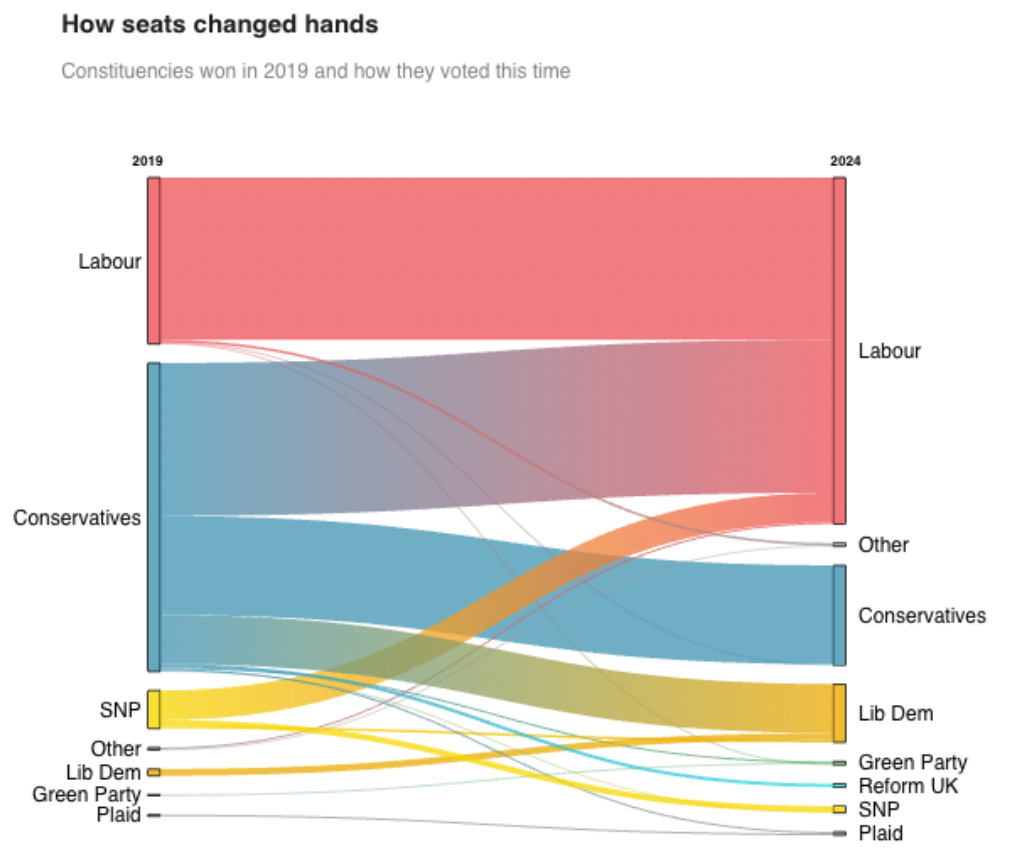I spent a very formative decade, including all of my teenage tears, in Britain. It wasn’t the easiest of times, but the experience shaped my outlook and character and I have never lost interest in the fate of the country. Watching the election results trickle in on the night of July 4 brought back a lot of memories.
The story of the election is roughly this. Labour won more than 63 percent of seats with less than 34 percent of the popular vote, as the Conservatives bled support to both the populist Reform UK and the moderate Liberal Democrats. We in the United States complain about the electoral college, but consider this—Reform won just 5 seats (out of 650) despite getting 14 percent of the popular vote, while the Lib Dems won 72 seats with 12 percent. Labour mopped up in formerly Conservative constituencies where Reform surged, while the Lib Dems nabbed a significant share of the rest:
This reminded me a bit of the 1983 election, in which the governing Conservatives expanded their parliamentary majority despite a decline in their share of the popular vote, against a splintered opposition composed of Labour and an alliance between the Liberals and the newly formed Social Democratic Party (SDP). Like Reform today, the alliance placed second in a lot of constituencies, winning just 23 seats despite getting more than a quarter of the popular vote.
There are many important differences between the two elections of course, not least of which is that the alliance was hardly a populist movement. The SDP was formed when four prominent members of parliament split from Labour following the surprise victory of Michael Foot over the more moderate Denis Healey for the party leadership, and the increasing influence of Tony Benn.
Healey and Benn were unforgettable and very British characters.
Anthony Wedgwood Benn was barred from taking a seat in the House of Commons because he held the title of Viscount Stansgate, which made him eligible for a seat in the House of Lords. He was eventually allowed to renounce his title in 1963 following a change in the law, and did so right away. Healey was unusually jovial and affable for a politician but apparently had sharp elbows, and if you’ve never seen his eyebrows you really must.
If Healey had won the leadership race in 1980, there would have been no SDP, and no Lib Dems today, since the party was formed when the Liberal-SDP alliance was solidified by a merger. I suspect that Labour would have won quite handily in 1983, despite the rising popularity of Margaret Thatcher in the wake of the Falklands war. And the history of the country, for better or worse, would have been quite different.
Getting back to the present, it seems that Reform is here to stay, and this leaves the Conservatives in a dilemma. They could move in a more populist direction and try to claw back votes lost to Reform, in an attempt to regain seats lost to Labour. Or they could moderate their approach and try to recover their losses to the Lib Dems. But as noted in this very informative thread, it would be difficult to do both, and neither one is likely to be sufficient in any case.
Which way will the Tories go? It looks like the early favorite in the leadership race is Kemi Badenoch, which would suggest the elevation of cultural issues and the adoption of more populist positions. Meanwhile Nigel Farage has his sights set firmly on Labour voters, and this strategy could well succeed.
As I prepare to post this, the second round of the French elections are underway with a surging populist right, and it is still not clear who will contest the US presidential election in November as the official nominee of the Democratic party.
We live in interesting and turbulent times.



FPTP is a horrible system but it’s worth noting that the LibDems won 11% of the seats with 12% of the votes which doesn’t seem that out-of-whack.